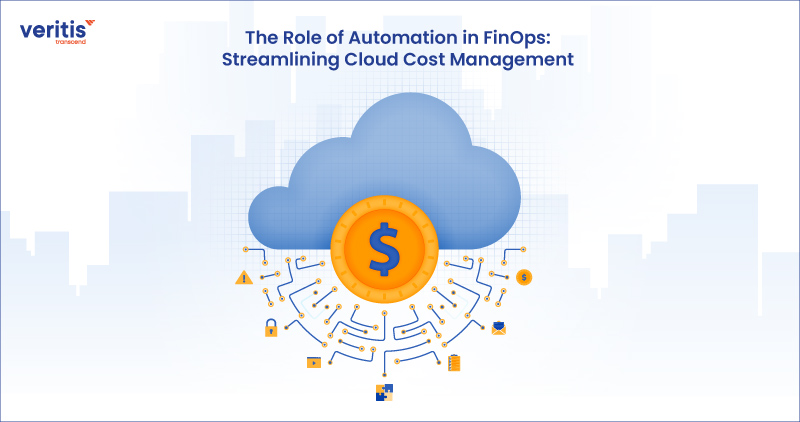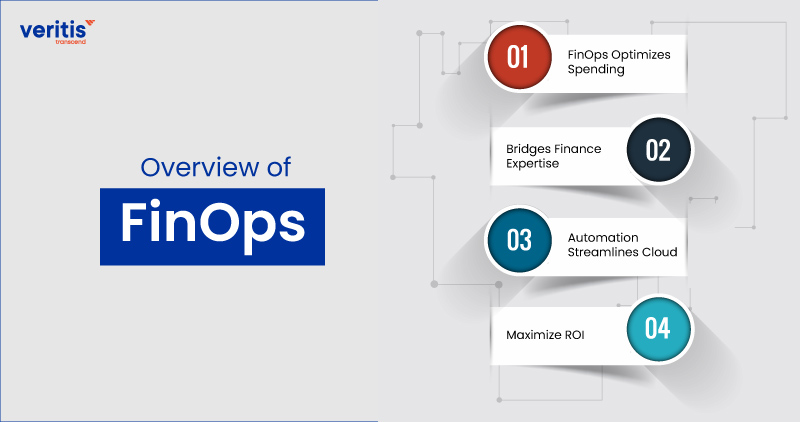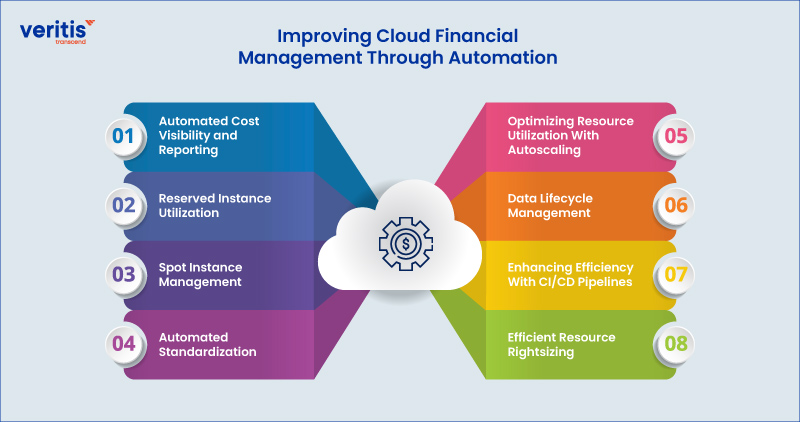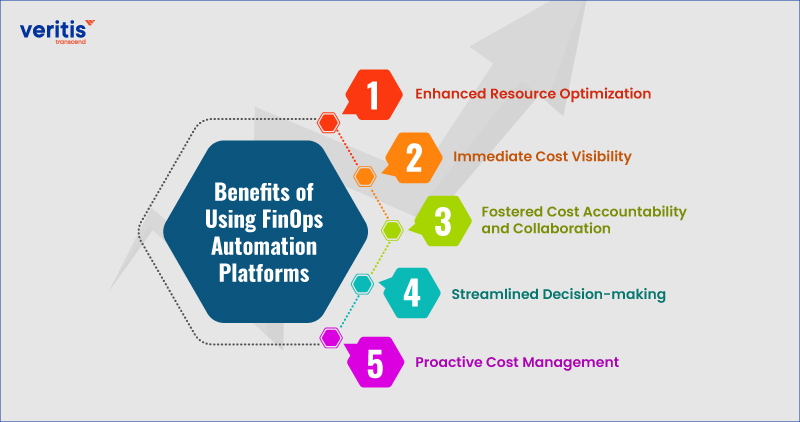
In the swiftly advancing cloud computing domain, effective cost management has become paramount for organizations striving to optimize resources and maximize returns. This critical aspect is where Financial Operations (FinOps) practices come into play, focusing on aligning cloud spending with overarching business objectives. Automation is a pivotal element that transforms cloud cost management tools. By seamlessly integrating automation into FinOps processes, organizations can streamline financial operations, enhance efficiency, and gain precise control over their cloud expenditures.
The huge demand for public cloud services has accelerated businesses’ application migration, necessitating swift monitoring and reporting of cloud expenses across teams. However, as organizations embraced cloud migration for potential data center cost savings, they encountered new financial challenges.
Today, cloud services’ return on investment (ROI) has taken center stage, particularly amid economic downturns. A recent survey underscores this urgency, revealing that 81% of IT leaders face pressure from executives and boards to reduce cloud spending or curb additional expenses.
Automation emerges as a transformative solution for tackling the financial complexities linked with cloud migration. By harnessing automation within FinOps practices, businesses can achieve unparalleled efficiency, agility, and accuracy in their cloud financial management strategies, ultimately boosting productivity and effectiveness in today’s dynamic cloud environment.
Overview of FinOps

In response to the increasingly complex field of cloud financial management, FinOps has emerged as a crucial framework for businesses aiming to gain control and optimize their cloud spending. As organizations transitioned to cloud computing, they encountered new challenges surrounding cost transparency, accountability, and efficiency.
Historically, IT financial management relied heavily on capital expenditure (CapEx) and fixed budgets. However, the rise of cloud services introduced a paradigm shift towards operational expenditure (OpEx) and pay-as-you-go pricing models. This shift necessitated a more agile and adaptable approach to financial management.
FinOps represents the convergence of financial expertise with an understanding of cloud technology. It addresses the need for a specialized approach to managing cloud costs effectively. FinOps enables organizations to optimize their cloud spending while aligning with business objectives by bridging the finance, technology, and operations gap.
Despite its benefits, implementing FinOps comes with challenges. One of the primary hurdles is achieving comprehensive cost visibility. This involves accurately attributing costs to specific teams or projects and promptly identifying anomalies. However, traditional methods of manual resource tagging and cost monitoring can be labor-intensive and inefficient.
Enter automation—an indispensable solution for organizations striving to enhance their cloud financial management processes. Automation enables businesses to streamline FinOps practices by leveraging technology to drive efficiency, accuracy, and scalability. Organizations can maximize their ROI on cloud investments by automating resource tagging, cost analysis, and optimization recommendations while minimizing manual effort and errors.
Useful Link: How Financial Risk Management Software Mitigates Fraud in the Financial Industry
What is FinOps Automation?
FinOps automation entails using tools to streamline, optimize, and automate many tasks related to proficient cloud cost management tools. By facilitating enhanced decision-making and dynamic cost optimizations in real-time, these tools empower organizations to manage their cloud expenses efficiently. This encompasses monitoring expenditures, scrutinizing spending trends, refining, allocating, and providing cloud resources, and effectively utilizing applicable discount mechanisms.
How Does FinOps Automation Work?

A fundamental aspect of FinOps automation is its capacity to analyze past data and discern patterns in cloud expenditures, thereby clarifying costs and uncovering avenues for cost reduction.
Through a FinOps platform, optimization suggestions are generated based on this analysis, and the platform can implement them automatically. These recommendations span various strategies, such as leveraging discounts, optimizing instance sizes, eliminating underutilized resources, and detecting irregular costs.
Moreover, FinOps automation solutions furnish valuable metrics and insights that empower organizations to refine their cloud management strategies. From predictive analytics to meticulous cost allocation, these tools equip companies with the information and transparency necessary to enhance their utilization of cloud spend management resources.
Role of Automation in Cloud Cost Optimization
In cloud cost optimization strategies, automation is pivotal in simplifying what would otherwise be a complex and labor-intensive process demanding specialized expertise. Fortunately, platforms such as Veritis, designed for cloud FinOps tools automation, eradicate these challenges, enabling enterprises to implement a fully automated strategy for cost optimization.
Automation in FinOps significantly streamlines and improves cloud cost management solutions optimization by:
- Automatically applying suitable discount mechanisms tailored to the specific workload requirements.
- Continuously adjusting instance sizes to align precisely with demand, a process known as rightsizing.
- Identifying anomalies in costs to pinpoint unexpected price increases swiftly.
- Efficiently allocate and tag costs to enhance tracking and ensure accountability.
Tools automate the intricacies of cloud cost management solutions optimization, eliminating the complexities and uncertainties and making managing cloud finance expenses more accessible and dependable.
Useful Link: How Veritis Anticipates and Resolves Financial Service Challenges
Improving Cloud Financial Management Through Automation

Automating cloud financial management processes can significantly streamline business operations, providing enhanced efficiency and cost optimization across various aspects of cloud finance usage. Here’s how automation can make a difference:
1) Automated Cost Visibility and Reporting
Automation tools collect and analyze data from cloud providers and services, offering comprehensive insights into spending patterns, cost allocation, and trends. Automated reporting generates detailed reports and dashboards, facilitating better decision-making, budget planning, and identifying optimization opportunities.
2) Reserved Instance Utilization
Managing reserved instances manually can be complex. Automation tools can automatically analyze usage patterns, recommend optimal reservation strategies, and handle the purchase, renewal, and retirement of reserved instances. This ensures organizations leverage reserved instances effectively, maximizing cost savings without manual intervention.
3) Spot Instance Management
Spot instances offer cost savings but come with the risk of interruptions. Automation tools monitor spot market prices, predict interruptions, and automatically switch to regular instances when needed, ensuring cost optimization while maintaining workload availability.
4) Automated Standardization
Automation solutions like Terraform enable infrastructure-as-code (IaC) approaches, facilitating fast iteration and reliable infrastructure management. By storing infrastructure code in a repository alongside application code, teams can deploy similar environments quickly, promoting faster development.
5) Optimizing Resource Utilization With Autoscaling
Autoscaling technologies dynamically allocate resources based on workload demands, ensuring efficient resource utilization and enhancing availability. Automation tools and advanced monitoring capabilities enable accurate workload forecasting and effective autoscaling implementation.
6) Data Lifecycle Management
Automation tools assist in managing data lifecycle processes such as archival, tiering, and expiration based on predefined policies, optimizing storage costs, and eliminating unnecessary expenses associated with retaining outdated or unused data.
7) Enhancing Efficiency With CI/CD Pipelines
Automation-powered CI/CD practices automate software building, testing, and deployment processes, minimizing errors, maintaining consistent release processes, and achieving higher efficiency. This enables faster delivery of software to production environments, fostering agility and competitiveness.
8) Efficient Resource Rightsizing
Automation solutions analyze resource usage patterns, identify overprovisioned or underutilized resources, and right-size them accordingly. Organizations continuously monitor and adjust resource allocations, optimize resource utilization, reduce unnecessary costs, and strike an optimal balance between performance and expenditure.
By leveraging automation across these areas, businesses can streamline cloud financial management processes effectively, optimize cost, and maximize ROI on cloud investments.
Useful Link: 5 Key Benefits of Implementing Cloud Financial Services for Your Business
Benefits of Using FinOps Automation Platforms

Embracing advanced FinOps automation platforms unlocks several pivotal advantages for organizations:
1) Enhanced Resource Optimization
Leveraging FinOps automation, platforms scrutinize real-time spending patterns to pinpoint underutilized resources and recommend cost-saving optimizations. These tools ensure the most efficient utilization of cloud resources purchased by rightsizing instances, eliminating redundant resources, and executing various optimizations.
2) Immediate Cost Visibility
Despite the widespread adoption of cloud computing across businesses, grasping cloud costs remains a significant hurdle for many organizations. FinOps automation platforms alleviate this challenge by providing real-time cost visibility and eliminating the need for manual data collection and analysis. This transparency enables companies to identify areas of waste and inefficiency swiftly, instill accountability, promptly detect spending irregularities, and unlock an array of business-boosting benefits.
3) Fostered Cost Accountability and Collaboration
The comprehensive cost visibility facilitated by FinOps automation platforms fosters a culture of accountability and collaboration within organizations. By utilizing cost allocation tags, companies can effortlessly track cloud spend management and usage across different departments, teams, and projects. This granular tracking cultivates an environment where everyone within the company is held accountable for utilizing cloud resources.
4) Streamlined Decision-making
FinOps automation platforms provide actionable insights derived from the comprehensive cost analysis. This enables leaders to make knowledgeable decisions regarding cloud resource utilization and allocation. By accessing real-time data and optimizing recommendations, organizations can swiftly adapt their cloud strategies to align with business objectives, fostering agility and efficiency in decision-making processes.
5) Proactive Cost Management
With cloud FinOps tools automation, organizations can proactively manage their cloud costs by setting up automated alerts and triggers for cost anomalies and budget overruns. By receiving timely notifications, teams can take immediate corrective actions, such as scaling down resources or adjusting configurations, to mitigate financial risks and ensure optimal cost efficiency over time.
Conclusion
Automation plays a vital role in streamlining cloud cost management tools and optimizing financial operations in the ever-evolving landscape of cloud services. By leveraging FinOps automation platforms, organizations can achieve enhanced resource optimization, immediate cost visibility, fostered cost accountability and collaboration, streamlined decision-making, and proactive cost management.
With firms like Veritis, a proud recipient of the Stevie and Globee Business Awards, businesses can unlock the full potential of FinOps automation, driving efficiency, cost savings, and agility in their cloud financial management strategies.
Looking for Support? Schedule A Call
Also Read:
- The Rise of Artificial Intelligence and Machine Learning in Financial Decision Making Processes
- Impact of Information Technology on the Financial Industry
- The Future of IT Financial Management: Trends and Innovations
- 5 Key Benefits of Implementing Cloud Financial Services for Your Business
- AIOps Use Cases: How Artificial Intelligence is Reshaping IT Management
- Overcoming Challenges: Implementing Generative AI in Healthcare